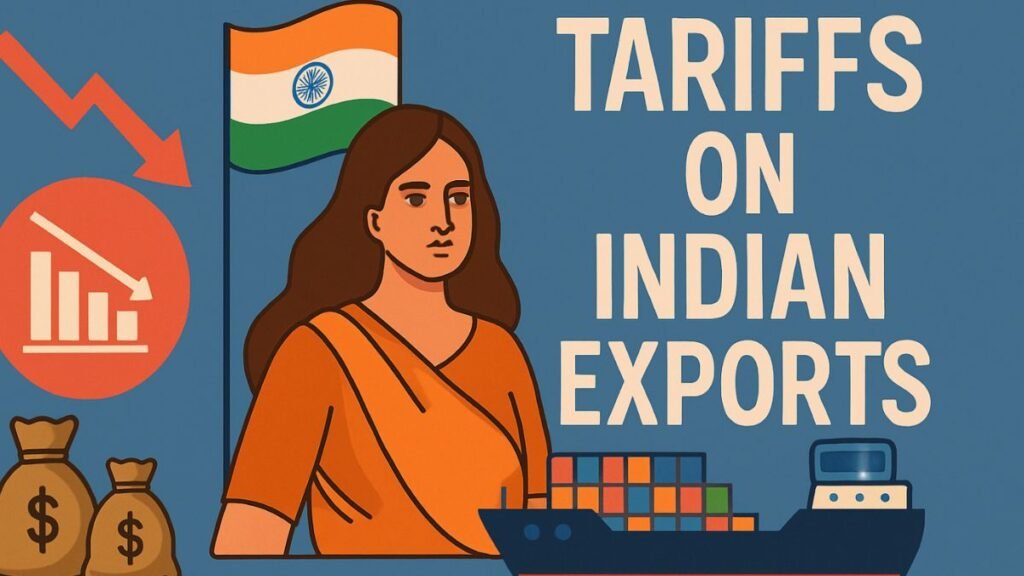Donald Trump Tariffs: For years, the Indo-US trade partnership was held up as a model for how two large democracies could align their economies for mutual benefit. But in recent months, that partnership has been tested in ways few anticipated.
Trade talks that once promised big gains for both sides have stumbled into a deadlock. The United States, under the Trump administration’s influence, came to the table with a long list of demands: sweeping market access for American agricultural goods, pharmaceuticals, and technology services. At the same time, it slapped steep tariffs on Indian exports like steel, aluminium, textiles, and IT services.
These demands clashed directly with India’s priorities. Prime Minister Narendra Modi’s government, determined to protect farmers, fisheries, and the small business backbone of the economy, stood its ground. Economists Stuart and Linda Stern, in their book India’s Economic Ascendancy: Navigating Global Trade Challenges, called it a “principled defence of economic sovereignty.” For India, giving in would have meant undermining key sectors that support millions of livelihoods.
What happened instead is telling: the standoff didn’t send India scrambling. It revealed just how much the country’s economic foundations have strengthened over the past decade.
US-India Tariff: How India Built the Resilience to Say “No”
India in 2025 is not the same as it was in 2010. Over the past decade, it has evolved into a far more diversified economic force. One of the key turning points was the 2014 launch of the Make in India initiative. This policy pushed for greater manufacturing capacity within the country, particularly in electronics, pharmaceuticals, and defence—three areas where dependence on imports once left India vulnerable.
The payoff is now clear. According to the Reserve Bank of India’s 2024 Annual Report, foreign exchange reserves have reached $700 billion, creating a sizeable buffer against external shocks. Even though the US is still an important trading partner, exports to America make up just 18% of India’s total exports, as per the Ministry of Commerce. That means tariffs affect a relatively small slice of the overall trade pie, less than 10% of export revenue.
Another factor cushioning the blow is domestic consumption. It accounts for over 60% of India’s GDP and is powered by a growing middle class and a fast-expanding digital economy. The Unified Payments Interface (UPI), which handled over 140 billion transactions in 2024, is a vivid sign of how active and self-sustaining the home market has become. In short, India doesn’t need to rely solely on exports to drive growth.
Turning Tariffs Into an Opportunity
Here’s the thing about crises: they tend to force decisions that have been postponed for too long. In India’s case, the tariff fight with the US is pushing the country to accelerate two strategic goals—achieving technological independence and widening its global trade network.
The Atmanirbhar Bharat (Self-Reliant India) vision is central to this push. Investments are pouring into sectors like semiconductors, 5G infrastructure, and renewable energy. The $10 billion semiconductor mission aims to have domestic chip production up and running by 2026, which would reduce one of the biggest external dependencies in modern manufacturing.
Meanwhile, the Production-Linked Incentive (PLI) scheme has lured companies like Apple, Samsung, and Foxconn to expand manufacturing in India. According to the Ministry of Electronics and IT, electronics exports rose by 22% in 2024 alone.
On the trade side, India has been actively negotiating with and signing agreements outside the US orbit. Free trade deals with the UAE and Australia are already in place, while talks with the UK are ongoing. The Confederation of Indian Industry projects that exports to non-US markets could rise by 15–20% each year over the next five years. The shift isn’t about replacing the US as a partner, but about ensuring India never has all its eggs in one basket.
The US Tariff Backlash: Why American Consumers Will Feel It First
While India adjusts its sails, the US risks steering into domestic trouble. Tariffs don’t just hurt the exporting country; they raise costs for the importing country’s consumers.
American importers of Indian pharmaceuticals, textiles, and auto components will pay more. They’ll pass those higher costs down the line. A 2024 Peterson Institute study estimates these tariffs could increase the annual cost of living for US households by $1,200 to $1,500. That’s no small hit, especially for middle- and lower-income families.
The situation is particularly sensitive in healthcare. The US Chamber of Commerce has warned that tariffs on Indian pharmaceuticals could disrupt the supply of generic drugs, which make up 90% of US prescriptions. That could drive up healthcare costs in a country already wrestling with high medical bills.
Economist Joseph Stiglitz put it bluntly in a New York Times op-ed: protectionist policies like these risk feeding inflation and shaking consumer confidence. If that happens in an election cycle, voter frustration could become a serious political liability.
Geopolitical Ripples: India Steps Into a Bigger Role
Trade disputes don’t happen in a vacuum. The current standoff is giving India room to reposition itself on the global stage. By refusing to bow to tariff pressure, India is showing other nations that it can stand up to economic coercion.
This is opening new diplomatic doors. India is signalling deeper engagement with BRICS partners and reviving interest in the Russia-India-China (RIC) format. PM Modi’s planned visit to Beijing for the 2025 Shanghai Cooperation Organisation summit and his talks with Brazilian President Lula da Silva point to a deliberate strategy: diversify not just trade, but alliances.
These moves strengthen India’s leverage in a multipolar world. They allow India to work with a wider set of partners while reducing the risk of overdependence on any single power bloc.
Why This Moment Matters
The last time India faced this kind of external economic pressure, its economy was far less prepared. Today, it has foreign reserves, a strong domestic market, a thriving tech sector, and a growing global footprint.
Instead of being thrown off balance, India is using this moment to double down on long-term priorities:
- Building technology at home instead of importing it
- Expanding trade partnerships beyond traditional allies
- Using diplomatic capital to strengthen its role in global governance
The US, in contrast, is facing the possibility of its tariff strategy backfiring at home. Inflation, disrupted supply chains, and higher consumer costs could all feed into political discontent.
The Road Ahead
The Indo-US trade story is far from over. Both sides still have significant reasons to cooperate, trade, investment, defence, and technology among them. But for now, the tariffs have drawn a line in the sand.
India’s refusal to compromise on its economic sovereignty sends a clear signal: it will negotiate, but not at the cost of its core industries and long-term stability. This kind of stance can frustrate partners in the short term, but in the long run, it builds respect.
If India continues on its current path, investing in domestic capabilities, diversifying its trade links, and playing a smart diplomatic game, it could emerge from this chapter stronger than before.
What this really means is that the so-called tariff crisis may end up being less of a setback and more of a turning point. For India, it could mark the start of a new era: one where it plays by its own economic rules and sets the terms of engagement with the world.
Disclaimer: These are the personal opinions of the author
Read More: Donald Trump Tariffs: The World’s Nuclear Domino Effect and the Risk Ahead




